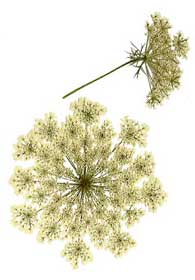![]() Prices in Canadian Dollars.
Prices in Canadian Dollars.![]() Prefer to call and speak to a floral agent? 1-877-277-4787
Prefer to call and speak to a floral agent? 1-877-277-4787
Queen Anne’s Lace
QUEEN ANNE’S LACE
Ammi majus
Wild Carrot, Wildflower Seed, Bishop’s Lace or Queen Anne’s Lace is a flowering plant in the family Apiaceous, Probably originally a native of the sea-coasts of Southern Europe degenerated into its present wild state, but of very ancient cultivation. The name ‘Carrot’ is Celtic, and means ‘red of color,’ and Daucus from the Greek dais to burn, signifying its pungent and stimulating qualities.
 Queen Anne’s lace is said to have been named after Queen Anne of England, an expert lace maker. English legend tells us that Queen Anne challenged the ladies of the court to a contest to see who could produce a pattern of lace as lovely as the flower of this plant. No one could rival the queen’s handiwork. She however, pricked her finger with a needle and a single drop of blood fell into the lace that is said to be the dark purple floret in the center of the flower.
Queen Anne’s lace is said to have been named after Queen Anne of England, an expert lace maker. English legend tells us that Queen Anne challenged the ladies of the court to a contest to see who could produce a pattern of lace as lovely as the flower of this plant. No one could rival the queen’s handiwork. She however, pricked her finger with a needle and a single drop of blood fell into the lace that is said to be the dark purple floret in the center of the flower.
During the flowering period the head is nearly flat or slightly convex, but as the seeds ripen the form becomes very cup-like; hence one of the popular names for this plant is “bird’s nest.” The seeds are covered with numerous little bristles arranged in five rows.
Wild carrot is edible when young but the root (especially the center) soon gets tough.
It is yellowish in color, spindle-shaped, slender, firm and woody; a pernicious weed in some areas.
Care and Handing:
- There is no special post-harvest treatment needed for Queen Anne’s Lace. Clean water in a clean vase will suffice.
- Queen Anne’s Lace is not Ethylene sensitive.
- We recommend that you defoliate Queen Anne’s Lace before using in bouquets and/or arrangements.
- The foliage tends to turn yellow quickly, but it does not adversely affect the flower umbels.
Design Suggestions:
- Often used for wedding work
- Queen Anne’s Lace has made a big comeback in popularity in the past several years. It tints well (immersion) and should be cut on the green side (40% open), otherwise it will drop little white specks everywhere once the florets fully open.

